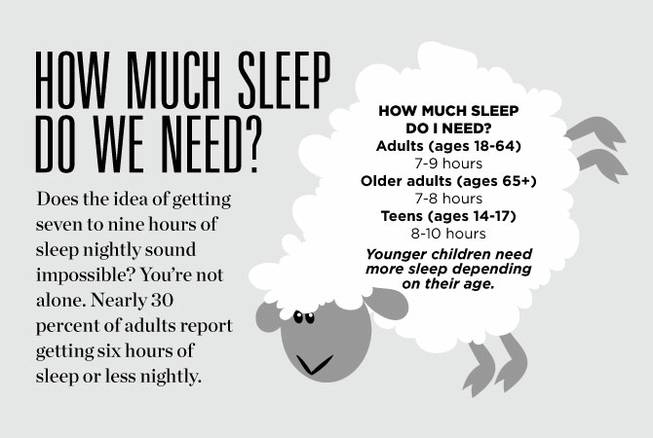
Sunday, March 6, 2016 | 2 a.m.
The average person spends one-third of his or her life sleeping, but an estimated 50 million to 70 million adults in the United States suffer from a sleep or wakefulness disorder. In September, the Centers for Disease Control and Prevention declared insufficient sleep, in addition to diseases and other health concerns linked to a lack of sleep, a public health problem.
Sleep disorders can be caused by neurological disease or environmental factors. Regardless of the cause, the fact remains that most of us just aren’t getting enough sleep.
How much sleep do we need?
Adults (ages 18-64): 7-9 hours
Older adults (ages 65+): 7-8 hours
Teens (ages 14-17): 8-10 hours
Younger children need more sleep depending on their age.
Does the idea of getting seven to nine hours of sleep nightly sound impossible? You're not alone. Nearly 30 percent of adults report getting six hours of sleep or less nightly.
Why do we need sleep?
Some mystery remains about the exact purposes and mechanics of sleep, but it’s a critical time for the body and brain to restore, process and strengthen. While scientists may not be able to pinpoint what happens while we’re sleeping and why we need sleep, they are able to identify the consequences of not getting enough sleep:
Short-term effects
• Anxiety, irritability, moodiness, impulsivity
• Forgetfulness, memory and cognitive impairment
•Inability to focus, decreased alertness
Long-term effects
•Hypertension (high blood pressure)
•Diabetes
•Increased risk of heart attack
•Increased risk of stroke
•Obesity
•Depression and mood disorders
Common sleep disorders
Insomnia
Insomnia is the most common sleep disorder and can be acute or chronic. It causes wakefulness, difficulty falling asleep and difficulty going back to sleep.
Insomnia can be caused by a medical or psychiatric problem, excessive stress or environmental influences. In some cases, however, it can occur for no obvious reason at all.
Narcolepsy
Narcolepsy is a condition in which the sufferer is unable to control when he or she falls asleep. As a result, the person experiences excessive daytime sleepiness.
Narcolepsy can be paired with other symptoms such as sleep paralysis and hallucinations. Though a relatively uncommon disorder — it affects about 200,000 people in the United States — it can be damaging to a person’s quality of life.
Restless leg syndrome
Restless leg syndrome is a neurological disorder that makes people feel an overwhelming urge to move their legs while resting. There are many reasons someone might have restless leg syndrome, but common risk factors include:
•Parkinson’s disease
•Iron deficiency
•Kidney failure
•Diabetes
•Peripheral neuropathy
Pregnancy also may spark bouts of restless leg syndrome, and some medications may cause it as well.
Sleep apnea
Obstructive sleep apnea occurs when a person stops breathing for several seconds while sleeping. This is caused by a blockage in the upper respiratory system. During sleep, soft tissues in the throat relax and collapse, blocking the airway. This can result in snoring and the brain partially waking up to get more oxygen, which can lead to insufficient and/or reduced quality of sleep.
How disorders are diagnosed
Some sleep disorders, such as insomnia, can be self-diagnosed or diagnosed by a doctor through a series of questions. Sleep apnea, restless leg syndrome and narcolepsy all need to be diagnosed by a medical professional and may require more extensive testing.
Technology’s impact on sleep
Darkness sends important signals to the brain that it’s time to start winding down for sleep. Bright light sends signals to the brain telling it to wake up. Because of increased use of personal technology such as cellphones, laptops and TVs, those signals are getting interrupted for many people. The bright glow of a screen can trick your body into thinking it’s supposed to be awake, even if you’re trying to fall asleep. People who use devices late into the night often have a harder time falling asleep and staying asleep.
Tips for getting better sleep
•Sleep in an environment that’s dark, quiet and cool. Light and noise can keep you awake or wake you up throughout the night. The temperature of the room also can affect your quality of sleep. Many people sleep best in a room that’s kept between 65 degrees and 68 degrees.
•Go to bed at the same time every night and wake up at the same time every morning. Sleeping in on the weekends may feel good, but it can throw off your body’s internal clock. If you do sleep in, keep it to an hour minimum.
•Don’t eat large meals close to bedtime.
•Stop using electronic devices at least two hours before bedtime.
•Avoid consuming caffeine and alcohol close to bedtime.
•Avoid nicotine entirely. It’s a stimulant.

Join the Discussion:
Check this out for a full explanation of our conversion to the LiveFyre commenting system and instructions on how to sign up for an account.
Full comments policy